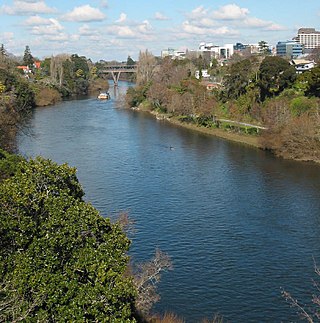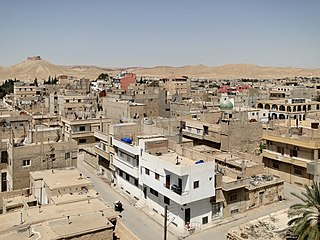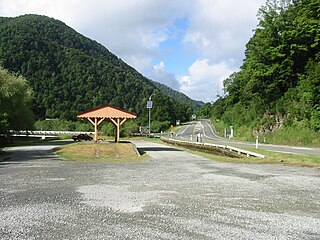Palmyra is the ancient Greek name for the Syrian city of Tadmur.

The Waikato River is the longest river in New Zealand, running for 425 kilometres (264 mi) through the North Island. It rises on the eastern slopes of Mount Ruapehu, joining the Tongariro River system and flowing through Lake Taupō, New Zealand's largest lake. It then drains Taupō at the lake's northeastern edge, creates the Huka Falls, and flows northwest through the Waikato Plains. It empties into the Tasman Sea south of Auckland, at Port Waikato. It gives its name to the Waikato region that surrounds the Waikato Plains. The present course of the river was largely formed about 17,000 years ago. Contributing factors were climate warming, forest being reestablished in the river headwaters and the deepening, rather than widening, of the existing river channel. The channel was gradually eroded as far up river as Piarere, leaving the old Hinuera channel through the Hinuera Gap high and dry. The remains of the old course are seen clearly at Hinuera, where the cliffs mark the ancient river edges. The Waikato's main tributary is the Waipā River, which converges with it at Ngāruawāhia.

The Motueka River is located in the north of the South Island of New Zealand and is a popular tourist destination for watersports and fishing. The Motueka flows 116 kilometres (72 mi) from the mountains 40 km west of the city of Nelson in the southeast of the catchment and flows north to the Tasman Bay.

Tapawera is a small town in the Tasman District of New Zealand's South Island. It is located 76 km southwest of Nelson and 48 km southeast of Motueka. It is situated on the Motueka Valley Highway by the banks of the Motueka River.

Palmyra is a city in central Syria, administratively part of the Homs Governorate. It is located in an oasis in the middle of the Syrian Desert 215 kilometres (134 mi) northeast of Damascus and 180 kilometres southwest of the Euphrates River. The ruins of ancient Palmyra, a UNESCO World Heritage Site, are situated about 500 metres southwest of the modern city centre. Relatively isolated, the nearest localities include Arak to the east, Al-Sukhnah further to the northeast, Tiyas to the west and al-Qaryatayn to the southwest.
Tadmor prison was located in Palmyra in the deserts of eastern Syria approximately 200 kilometers northeast of Damascus.
Hayim Tadmor was a leading Israeli Assyriologist. As a student of Benno Landsberger and Sidney Smith, his knowledge was grounded in immediate knowledge and experience that went back to the earliest years of Assyriology.
Betawi, also known as Betawi Malay, Jakartan Malay, or Batavian Malay is the spoken language of the Betawi people in Jakarta, Indonesia. It is the native language of perhaps 5 million people; a precise number is difficult to determine due to the vague use of the name.

The Flying Dutchman (1846–1870) was an English Thoroughbred racehorse and sire. He raced for four seasons between 1848 and 1851, winning all but one of his fifteen races, including The Derby and the St Leger. On his final racecourse appearance he defeated Voltigeur in what was probably the most celebrated match race in the history of British thoroughbred racing, known as The Great Match. He went on to be a success at stud both in Britain and France, where he died in 1870. The Flying Dutchman was regarded by experts as one of the greatest British racehorses of the nineteenth century.
The following lists events that happened during 1874 in New Zealand.

The Nelson Section was an isolated government-owned railway line between Nelson and Glenhope in the Tasman district of New Zealand's South Island. While part of the New Zealand Government Railways, the section was never connected to the national railway network, although there were plans to do so. The line operated for 79 years between 1876 and 1955. Unusually for an isolated line, there were passenger and freight services for most of its existence, with freight outlasting passenger services by just a year.
The New Zealand Derby was a set-weights thoroughbred horse race for three-year-old horses run over a distance of 2400m at Riccarton Racecourse in Christchurch, New Zealand. The inaugural running of the Derby was in 1860, when racing was held at Riccarton Racecourse.
The Leipzig–Jakarta list of 100 words is used by linguists to test the degree of chronological separation of languages by comparing words that are resistant to borrowing. The Leipzig–Jakarta list became available in 2009. The word list is named after the cities of Leipzig, Germany, and Jakarta, Indonesia, the places where the list was conceived and created.

Cheq Wong is an Austroasiatic language spoken in the Malay Peninsula by the Cheq Wong people. It belongs to the Northern subbranch of the Aslian languages. Northern Aslian was labelled Jehaic in the past.
On 26 June 1980, an assassination attempt on Hafez al-Assad, the Syrian president, was carried out by Muslim Brotherhood supporters who threw two grenades and fired machine gun bursts at him as he waited for an African diplomat in the Guest Palace in Damascus. Assad kicked one grenade out of range, whilst one of Assad's bodyguards threw himself on the other grenade.
Tadmor or Tadmur is an ancient Semitic name, and may refer to
Tadmor is an extinct town in Montgomery County, in the U.S. state of Ohio. Its location, 39°53′45″N84°9′55″W, is now within the Vandalia city limits.

Zehev Tadmor is a retired Israeli chemical engineer who has served as distinguished professor, president, and chairman of the Technion-Israel Institute of Technology. He is also chairman of the Samuel Neaman Institute for Advanced Studies in Science and Technology, a policy research center. His main research interest is polymer and plastics engineering and processing. He won the Emet Prize in 2005.










